 |
Kramer
Aluminum Neck Guitars
| The
Kramer aluminum neck era ran from 1976 to 1985 and was the legacy
of the company before switching over to the more popular wood neck
models uring the 80s. The first production batch of Kramers were
introduced in November 1976. All of these early Kramers featured
a "forked" aluminum headstock and aluminum "skeletal"
neck (the Dukes had no headstock). These necks, designed for sustain,
contained slots that ran the length of the neck for holding the
wood fills in place. (See diagram) The idea of the wood inlays were
to reduce the coldness feel of aluminum. Usually but not always,
the wood neck fills were the same type and color as the body. The
Ebonol fretboard contained large Phil Petillo designed "center-touch"
frets, a zero nut and aluminum dot inlays. The higher up models
had the mother of pearl "crown" shaped inlays. Scale lengths
were 25". Tuners were Schallers. They were manufactured at
the Kaiser Aluminum plant on East Avenue in Erie, Pennsylvania.
The necks were attached to the body by two bolts and the bolts were
covered by an oval shaped aluminum plate. Control cavity covers
were also aluminum. Some bass models were available fretless as
well as half fretted/half fretless also. |
|
|
|
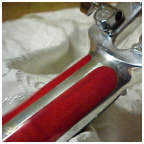 |
The
first pickups were chrome covered with "Kramer" etched
in the covers and pickup height was adjusted from the back of
the guitar. The first models also had walnut pickup surronds that
broke rather easily. Pickups were of an unknown origin but rumored
to be Mighty Mites. Body woods in the beginning were fancier imported
woods like koa, bubinga, swetenia, afromosia, etc. before going
on to plain maple and walnut. |
Steve
Z - Former Kramer Employee
Construction notes about Oval Neckplates
"The three hex bolts were sufficient to attach the metal necks
but by the time the Dukes and Headless V'gers came out the oval neck plates
were obsolete. It would have made sense to use shorter screws to affix
the plates but that would have been one more parts bin to mix up. So long
bolts were used but they just screwed into the inserts (Sticks) on the
metal necks. Since the sticks were glued in they wouldn't have been strong
enough alone so you instead you had overkill on the neck bolts. We had
tons of those hex bolts and they had to be shortened for some applications
like attaching the nuts on the duke. That meant a pair of bolt cutters,
followed by a grinding wheel, then a wire wheel. Would it have been cheaper
to buy shorter bolts? Not the Kramer way."

Early Models - 250, 350, 450, and 650
The
first run of guitars were the 450G(guitar), 450B(bass) and the cheaper
350G and 350B. The 450s and 350s both had offset double cutaway bodies.
The 450s had a walnut body with 2 maple strips going down the middle.
450s also had 2 humbuckers, 3 way switches, 2 vol and 2 tone knobs and
a combo bridge/tailpiece. The earlier 450s also had square block shaped
inlays on the fretboard. In 1977, when the new generation series came
out, the 450 became the 450 Deluxe which had slightly shorter horns.
The 350 series was a cheaper alternative to the 450s. The 350 guitar
had a smaller body and 2 single coil chrome covered pickups while the
350 bass had only one pickup. The 350 and 450s lasted until 1979 and
1980, respectively.
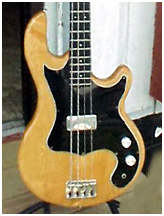 |
 |
 |
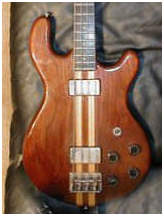 |
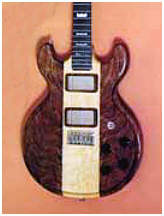 |
250B |
250G |
350G |
450B |
650G6 |
| In
1977, Kramer issued the even cheaper 250 series guitar and bass
which essentially was the same as the 350s but had a black pickguard
and were only offered in black or white. In the same year the top
of the line 650G(Artist series guitar) and 650B(bass) were issued.
These bodies were different shaped as to make the cutaways more
equal and the body was comprised of a thick bird's eye maple center
sandwiched by fancy walnut wings. These guitars also had a German
rim route on the face and pearl crown inlays, 2 vol, 2 tone and
3 way switch. The bass version had the same attributes as the guitar.
The 650 series made it to 1980 also. |
|
| |
1978
- 650B Fretless with Fret Dots |

DMZ
Series
In 1979, the DMZ series appeared. The DMZ name, based on it's use
of DiMarzio pickups contained several models; 4 guitars and 3 basses.
Also at this time, Kramer began using a roller-type nut instead
of the older type to reduce friction and tension.
The DMZ 1000 featured a heavy maple body in black or natural with
2 DiMarzio Distortion hum pickups and a Badass bridge. The 1000
also had the slimmer body and horns like DMZ 5000 model bass. Controls
were 2 vol, 2 tone and 3 way switch. |
|
The
DMZ 2000 was the same guitar as the 1000 but with a walnut/maple construction
body option and 2 coil tap switches added. The DMZ 3000 was a natural
maple (available in black also) bodied 3 single coil pickups on a black
pickguard with Strat-ish styled bridge. Controls were 1 vol, 2 tone
and 5 way select.
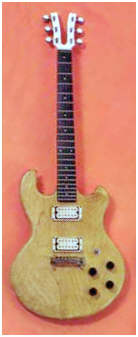 |
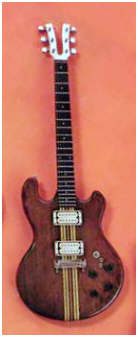 |
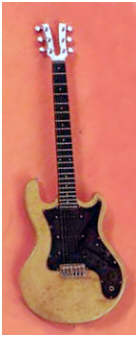 |
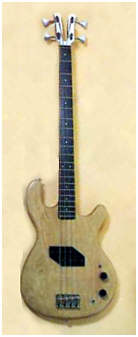 |
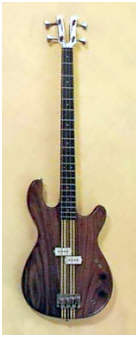 |
|
DMZ
1000 |
DMZ
2000 |
DMZ
3000 |
DMZ
4000 |
DMZ
4001 |
DMZ
5000 |
Also debuting in 1979 as one of the DMZ Customs was the DMZ4000 bass.
At first, it sported the fatter bulbous
body like the DMZ2000 and 3000 guitars. It also had a mini-pickguard
in the middle of the body that held a passive split-coil Dimarzio P-bass
pickup. Controls on the early version were 1 volume and 1 tone knob
and face-mounted jack. This first mach was availble in black(maple body),
natural(maple body) or walnut/maple combination. Later that year, the
4000 lost it's pickguard and gained an active EQ and Dimarzio Dual Coil
pickup instead of the passive model used on the earlier version. It
gained 2 switches, one for power and one for coil tap. Around this time,
the 4000 was planned to be dropped and the DMZ4001 was to take over.
The 4001 was basically the same bass as the later 4000 version but had
only one coil tap switch. Both the 4000 and the 4001 initially had the
fatter body but was streamlined down to the thinner-horned, sleeker
body like the DMZ1000 guitar. Color options remained the same throughout
the run. Necks were standard aluminum with dot inlays and, like the
rest of Kramer's alum. neck basses, had the fretless or half fretless
option and some with no dots.
Basically, if it has a pickguard, it's a 4000 no matter what. The deciding
factor of the non-pickguarded models come down to the time frame the
model came out in. Although the 4000 and 4001 is listed as having active
curcuity, there are several examples of non-active, non switching configurations
on both models. The 4000 run was ended about the time the 4001 came
out with very little overlapping time. Both models at different times
sported passive and/or active electronics.
The 5000 was a slight departure from the others as far as body shape
which was thinner and more streamlined than as before. It had the walnut/maple
combo body, (although natural. and black were available), one Jazz and
one Precision pickup, crown inlays and 2 volumes, 2 tones and 2 coil
tap switches.
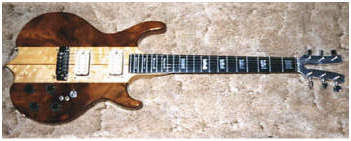 |
The
DMZ 6000 series consisted of a guitar and a bass. Not far off
from the 5000 bass, the 6000B had the same attributes as the 5000B
but had a thicker maple core consisting of 2 wide pieces of maple
and also had a distinctive double scoop out of the butt end and
20 frets. The 6000B also had a P & J pickup configuration
and crown inlays. The 6000G followed suit with the same features
but with 22 frets and 2 DiMarzio Dual Sound active pickups. The
6000 series were produced in limited numbers. |
DMZ
6000G |
|

XL series
The
XL series debuted in 1980 with three basses and two guitars; the XL-5,
7, 8, 9, and 24. These were divided into two different body shapes.
The XL-5(guitar), XL-8(8-string bass) and XL-24(bass)were based on the
type 1 body which was not unlike BC Rich's designs of the time. (see
picture below) Bodies were comprised of a radical shape of walnut and
maple strips or vice versa, 2 vol, 2 tones and coil tap switches.
|
|
|
|
|
|
|
XL5
Guitar |
XL8
Fretless 8 String |
XL7
Guitar |
XL9
Bass |
XL24
Black Bass |
XL24
Natural |
XL98
Bass |
The
XL-7(guitar) and XL-9(bass) had the type 2 slightly more conventional
shaped double cutaway bodies reminescent of the Floyd Rose signature
guitar but with thinner horns and a large triangular shaped maple core
in the middle flanked by walnut wings. These also came in cherry and
black finishes. The basses had 2 P pickups by Dimarzio and the guitars
had 2 Dimarzio X2N hums, 2 vol, 2 tone and 2 coil taps with a 3 way
switch and crown inlays. Both had active electronics.
The
XL-24 was a 4 string bass with the type 1 body and passive pickups.
The XL-12, a 12 string model and XL-98 8 string bass are still a mystery
as not much information exists on these models. Presumably these had
the type 2 body style.

XK
Series
In
1980, Kramer offered the XK series. This contained two guitars and two
basses. The guitars are labeled as the XKG, the basses as XKBs. First
was the "10" series which was a wedgeshaped body reminiscent
of a Randy Rhoads type shape with a notch cutout at the crotch. The
XKG-10 and XKB-10 both sported this type body. Controls on both were
one volume and one tone. Next was the "20" series which was
a clear copy of the DMZ1000 guitar shape minus the neck pickup. It was
a streamlined double-cutaway with one humbucker and a volume and tone
knob. The XKB-20 bass had a single P-bass pickup and one volume and
one tone. All XKs had face-mounted jacks. The "10"s had a
small oblong metal plate that held the controls and jack. Necks were
standard dotted fretboard aluminum with 22 frets for the guiatr and
24b for the bass.
|
|
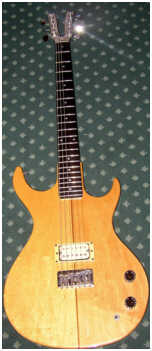 |
|
XKG-10 |
XKB-10
with Mods |
XKG-20 |
XKB-20 |
At this time Kramer began to expand it's color options and the new colors
available on the XKs were: natural, flame red, slate blue, pacific blue,
sundance orange, midnight black, electric yellow, arctic white and Aztec
rust. Original list price on the "10"s was $449 and the "20"
s was $549. The XKs were dropped in 1981.

Gene Simmons Axe
The
Gene Simmons Axe came in limited numbers and consisted of a guitar
and a bass. The Axe was, well...an old English Executioner styled
axe! Both the guitar and bass had a single pickup, 1 vol, and 1
tone. Simmons signed a number of them. Supposedly there were to
be 1000 of them but this is highly unlikely. Numbers are probably
much lower and some examples are simply not signed. It's estamated
that there are less than 500 out there. the guitar is actually quite
more uncommon than the bass. The Gene Simmons axes only lasted a
year and are highly collectable. There are many models out there
that claim to be original, but the truth is, if they aren't signed
by Gene, then they aren't legit. Additionally, the signature needs
to be sealed under the clearcoat in order for to be original. (according
to Peter LaPlaca, former Kramer exec)
Seen to the right is a write up in Guitar Player, 1981 on the Axe
Bass line of guitars. If you notice the fine print, it says "distributed
by BKL International, Barrington, Illinois." This probably
means that Peter LaPlaca retained some sort of ownership of the
Axe guitar and bass from Kramer after his departure. Notice no Gene
signature. |
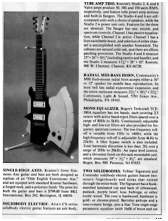 |
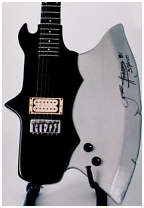 |
|

Duke Series
It
should be remembered that Kramer was very hip on what was happening
in the guitar world at all times, hence, the debut of the Duke series
in 1981. Clearly Kramer's answer to the then popular Steinberger, the
Duke took on a slightly more awkward appearance then the Steinberger
although maintaining the minimalist nod to it's inspiration. Comprised
of a wood body and aluminum/wood neck, the Dukes were tuned at the butt
or "swoop" of the instrument. There was also a rubbery skid
pad at the bottom to minimize slipping off your leg when playing sitting
down. Dots were aluminum also. Tuners were Schallers and the neckplates,
along with the Kramer logo and serial number read "The Duke".
|
|
|
|
|
|
 |
|
Standard |
Special |
Race
Stripe |
Rainbow |
Trans.
Blue |
White
Guitar |
Rare
- Natural |
Melaga
Purple |
The
Duke guitar and bass began as The Duke Custom or Standard guitar
and Duke Custom or Standard Bass depending on which Kramer literature
is sited as accurate. Features were one humbucker and 1 vol, 1
tone each.
Sometime
in 1982 the names were changed to the Duke Special guitar and
bass. Kramer literature sites the color options as only black,
white and creme. While most are black, many other colors have
been seen and it may be safe to assume that the Duke line was
offered in the same color options as all the other Kramers of
the time. Additionally, removable fretboard Dukes were produced
(seen right). There are also some out there with graphics and
bodies comprised of the walnut/maple combination. The Dukes made
it to 1985 at which time they were dropped.
A review of the Duke Bass from Circus Magazine can be seen by
clicking the image on the left. |
|
|

Challenger
The
Challenger came as one of Kramer's more strange moments. It consisted
of an inverted Voyager type body with the lower rear horn far extended
as well as the top front horn. The Challenger had the basic aluminum
neck with the tuning fork headstock and alum. dot inlays and Schaller
tuners. Pickups were twin Schaller hums with 2 volumes and 1 tone
control and 3 way switching.
The first Challengers came with the Rockinger trem and later switched
to the Floyd Rose in 1983 and became the Challenger Imperial. Most
will have the Rockinger trem as the Challenger itself was short-lived
and not as many were produced in the Floyd era. Colors ran among
the standard Kramer colors although most seen are black. The Challenger
was dropped in late 1983. |
|

Stagemasters
Most
people when they hear the words "Kramer Stagemasters" automatically
think of the awesome neck-through guitars Kramer/ESP produced in the
mid to late 80s. Actually the Stagemaster name was first applied to
a bolt-on aluminum neck model in 1981. They were just about identical
to the DMZ 6000 series guitars and basses. Standard colors were natural
walnut and maple, black, white, creme, tobacco sunburst, cherry sunburst,
red stain over walnut, red stain over maple, and graphics were also
available. There were four guitars and five bass models:
 |
 |
 |
|
 |
 |
 |
 |
Imperial |
Special |
Standard |
Deluxe
10 |
Imperial
Bass |
Special
Bass |
Standard
Bass |
Deluxe
8 Bass |
| Guitars
Stagemaster Imperial - 2 Ultra Spectrum or Schaller hums,
3 way switch, Schaller non-trem bridge or Flicker trem option,
walnut and curly maple woods and crown inlays. WOOD NECK option.
Stagemaster
Special - Same as Imperial but has two thin strips of maple
and middle section is made of walnut until later when it bacme
all walnut. Schaller bridge. Fret markers were dots. Black option
available.
Stagemaster
Standard - Maple body with red, black, sunburst, cherry sunburst,
creme and white available as finishes. Electonics and pickups
same as above.
Stagemaster
Deluxe 10 - 10 string doubling the 1st, 3rd, 5th, and 6th
strings. Extra tuners were in the butt area of the guitar. Dot
markers and was available in the same colors as the Standard. |
Basses
Stagemaster
Imperial - same as Imperial guitar with aluminum or wood neck option.
Features also the same as the guitar. Pickups were one P and one J pickup
which were Kramer Spectrums later changing to Schallers. 3 way
switch, 2 vols and 1 tone. Crown inlays and gold hardware available.
Stagemaster
Special - followed suit was the Special guitar. Dot inlays and hardware
in chrome.
Stagemaster
Custom - 2 hums, standard bridge, available in standard finishes.
Stagemaster
Standard - single hum, 1 vol and 1 tone. Available in standard colors.
Stagemaster
Deluxe 8 - Like the Deluxe 10 guitar. This bass doubled all four
strings again with the extra tuners in the scalloped area of the butt.
2 hums and same electronics as the Imperial. Standard color options.
The
Stagemasters along with the Dukes were the last line of aluminum necked
guitars and basses that Kramer produced. Some claim that they were the
best of the aluminum era. The Stagemasters were dropped with the Dukes
in 1985.
|
Custom Fretless Stagemaster |

Mystery Models - DMZ "335" Finally Found!!!
It was thought that the mystery 335 model was a figment of someone's imagination, however, it emerged in 2006 via a Kramer Forum visitor that the model does indeed exist. Evidently very few, if only 1 or 2 of these were made. The one shown below is painted in red, the other missing model that we have not seen yet is an unfinished version "prototype". It should also be noted that this model features the Schaller Hard Tail bridge.
|
The Mysterious DMZ 335 Kramer |
Hardware Rollernut Notes from
former employee Steve Z
1) The base was a cross section of the same aluminum bar stock that
was used for all of the nuts but cut thin and layed on the flat.
2)
The pins are steel rivets that are the same ones used to hold the tuners
in place.
3)
The rollers are guitar string ball ends. Probably D'addario's since
that was the brand purchased in bulk.
| Website
and Content © Copyright 2011 Infinite Sky Designs |
|



